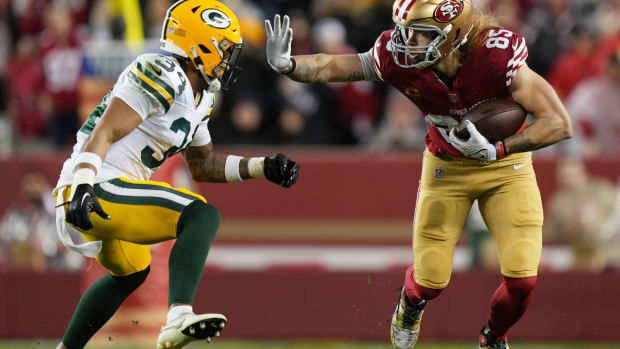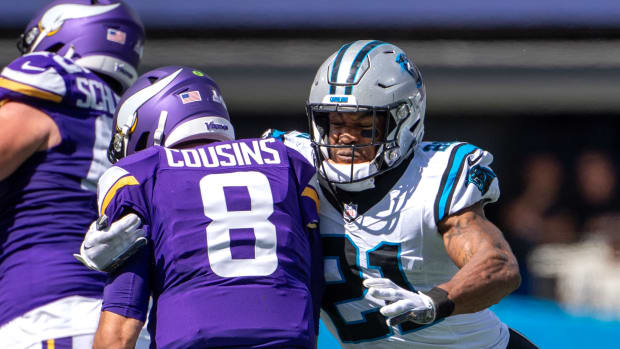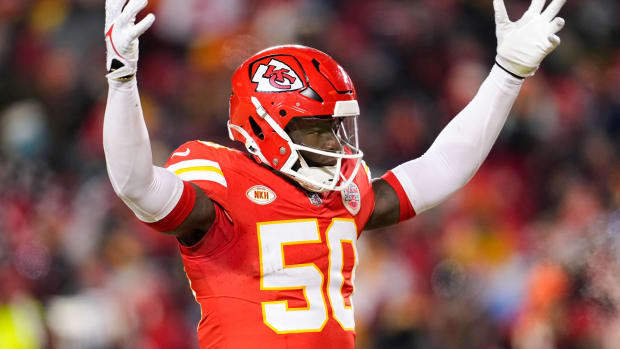2017 Draft Defined By Depth
I was chastised by a few people—including co-workers—for being critical of the 2013 draft class in March and April of that year. And my stock response was that, from everything I’d heard, 2014 would make up for the lack of talent in 2013.
We know how that turned out. There have been more 2013 top-10 picks that have switched teams (three) than have played in Pro Bowls (one). Meanwhile, 2014 brought us Jadeveon Clowney, Khalil Mack, Mike Evans, Anthony Barr, Odell Beckham, Aaron Donald, Zack Martin, C.J. Mosley, Derek Carr and many others.
So the good news for everyone five days after the Super Bowl: The way the 32 teams see it, the 2017 class they’re evaluating now is pretty damn close to what the 2014 group was going into the process.
“Depth-wise, it’s great,” said one AFC executive. “What I like about it is, if we do our job and have faith in our scouts, we can get starters into the fifth round.”
“It’s a very good draft,” added a top personnel executive for an NFC team. “If you’re in a position like Cleveland is with a lot of picks—and you still gotta pick the right guys—but it’s an excellent draft. Very deep across the board.”
Welcome to the first offseason edition of the Game Plan. Over the last few years my notes column hasn’t carried past the playing of games, so there’s going to be some tinkering here (basically, I’m throwing an “Under Construction” sign up). And as it’s normally set up, some elements are meant look forward to games, which obviously doesn’t work now. So bear with us. We’ll get it right.
We’re still going to hit on a bunch of different topics every week. This week, we’ll have more on Tom Brady’s ability to compartmentalize the emotion of last week, Steve Sarkisian as an NFL coach, where the Falcons go from here, the San Francisco staff setup, and much more.

The depth at wide receiver could lead teams to wait to pull the trigger on potential superstars like Clemson’s Mike Williams.
Sean Meyers/Icon Sportswire via Getty Images
But we’ll start with where the focus is for a lot of teams this week—looking forward to the draft. With plenty of teams in the midst of integrating coaches into the process, and meetings getting going, I called around in search of the defining characteristics of this year’s draft class with less than three weeks until the combine kicks off.
The first one that stuck out was the overall strength of the class. Here are six more …
• Mitch Trubisky is the leader among quarterbacks. There are two knocks on Trubisky: 1) Scouts aren’t sure how tall he’ll measure out, and 2) he only started one year at North Carolina, unable to beat out Marquise Williams before that. Taking that into account, Trubisky’s anticipation, accuracy, touch and experience with progression reads put him atop the class.
“I’ll be shocked if Trubisky’s not the first one off the board,” said our AFC exec. A scout for another AFC team added, “You’re gonna see the ascension of the Carolina quarterback. He’s the guy, a top-two or -three pick. He’s the guy. A lot of teams like him up there.”
So here’s the question: Are you comfortable taking an Andy Dalton or Teddy Bridgewater in the top five? The truth is, Trubisky’s promise is in offering a team stability—but not necessarily superstardom—at the most important position.
• You’re projecting with the rest of the QBs. One AFC college scouting director told me that DeShaun Watson is at least a year away from being able to run an NFL offense, and DeShone Kizer is two years away. Ex-Texas Tech teammates Patrick Mahomes and Davis Webb (who transferred to Cal) have talent, but both come from schemes that complicate their NFL transition. (Think Jared Goff.)
You’ll hear this is a bad quarterback draft. I’ve heard it from some people, and I’ve heard from others that it’s not as terrible as advertised. “It’s a good quarterback class,” said our NFC exec. “Realistically, all five of those guys go in the first two rounds.”
If that happens, it wouldn’t exactly be unprecedented, but that doesn’t happen every year. There have been five occasions (2014, ’12, ’11, ’07, ’06) since 2000 where five quarterbacks went inside the first two rounds, and only one (2011) where the number was higher than that.
• Joe Mixon is getting drafted. We’ve all seen the video. What Oklahoma’s Joe Mixon did in July 2014, on the day after his 18th birthday, was horrible and inexcusable. But what if that video hadn’t been released? Mixon probably is a candidate to go in the first round. And outside of an altercation over a parking ticket, Mixon’s kept his nose clean since.
“It needs to be the right market, a team that can handle the onslaught, the right PR staff, because you’ll have to weather the storm,” said one area scout assigned to the Sooners. “But the guy the Chiefs drafted [Tyreek Hill], Joe Mixon isn’t half the d-----bag that guy was. You’d have to search to find people that don’t like him. Maybe the parking-lot attendant. Everyone there loves him. And I believe them.”
It will take owner approval in this case. There are teams with history (like Baltimore) that simply won’t be able to draft Mixon. But this is a first-round prospect with Matt Forte/David Johnson potential as an every-down back. I think there’s a chance he goes before the Friday night of the draft is complete.
• The strength of the class is in the secondary and at running back. You’ve heard how this is an incredible year for running backs, and that remains true. Leonard Fournette and Dalvin Cook are lock first-rounders. If Christian McCaffrey runs the low 4.4/high 4.3 range, scouts expect he’ll be with them. (“Belichick never trades up,” said our NFC exec. “Bill may trade up for this kid.”) And there’s depth at the position, too.
So it’s interesting that it might not even be this class’ strongest group. At safety, Ohio State’s Malik Hooker and LSU’s Jamal Adams are both top-10 prospects. As many as five corners (Marshon Lattimore, Quincy Wilson, Teez Tabor, Marlon Humphrey, Sidney Jones) have a shot at going in the top 20. And at both secondardy positions there are other players who have a fighting chance at getting into the first round. If you need a top-shelf defensive back, you can find one in April.
• There are numbers at receiver and tight end. Alabama tight end O.J. Howard and Clemson wide receiver Mike Williams both have a chance to be picked in the top half of the first round. One factor that could hold each of them back—the strong numbers at their positions, which might just prompt teams to wait to fill needs at those spots.
At tight end, there is the raw freak athlete (David Njoku), more traditional tight ends (Jake Butt), and move-type H-backs (Jordan Leggett, Evan Engram). At receiver, there are polished prospects (Corey Davis) and game-breakers (John Ross). And the supply at both positions should run into the third and fourth rounds.
• The class does have a glaring weakness. That weakness is along the offensive line. The tackle crop isn’t as strong as usual, the guard group is shallow, and good luck finding centers. Worse, the fear in the NFL is that it’s not only a bad year but also a sign of things to come. “It’s a trend coming,” said our AFC exec, “because of the spread offense and all the rules on practicing.”
Outside of that? There’s not a lot of depth at inside linebacker, and the aforementioned debate at quarterback. Like we said, it’s not a bad year to have a lot of picks.
* * *
FIRST AND 10
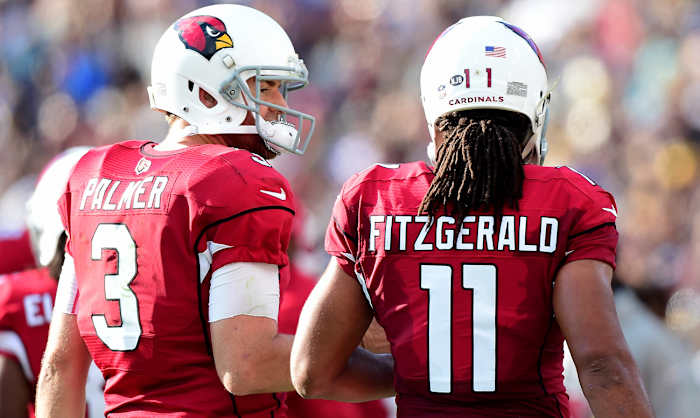
Carson Palmer have been teammates in Arizona for four years. The 2017 season might be their last.
Harry How/Getty Images
1. One rival executive called the Niners’ hire of Broncos college scouting director Adam Peters as VP of player personnel “spectacular.” That’s strong, but the move did go over well in the scouting community.
2. The league-wide feeling late in December was that Carson Palmer, Larry Fitzgerald and Bruce Arians were tied together. It’s possible 2017 is it for all of them.
3. Name I’d heard connected to the Cardinals if Arians had stepped away—Sean McVay. So fair to think post-Arians, Arizona would like a young offensive mind.
4. Dont’a Hightower has been a hero in two Super Bowls. But I think the Pats pass on franchising him. The $15 million figure is too high.
5. If the Hall of Fame committee is keeping Terrell Owens out for being a little divisive and crazy, it has lots of complicated cases coming. Next: Randy Moss.
6. Jeremy Bates was once a Sean McVay/Kyle Shanahan-level rising star. Part I of his NFL return, as Jets QBs coach: Help New York assess the potential of Christian Hackenberg.
7. Also worth noting on Bates: Mike Shanahan trusted him to call plays in 2008, even though Rick Dennison was Denver’s coordinator (Bates was QBs coach). And Jay Cutler loved him.
8. It’ll be interesting to see if Ben Roethlisberger tweaks his offseason routine, since he’s not getting any younger. Last spring/summer he added extra cardio.
9. Teams’ draft assessments of Jimmy Garoppolo may come into play regarding his trade market. Two teams that liked him a lot in 2014: Houston and New Orleans.
10. Smart by the Giants to take care of Steve Spagnuolo. His work last year in assimilating big-money free agents into the defense was a little overlooked.
• BURNING QUESTIONS, POST-SUPER BOWL: Albert Breer on what’s next for the Patriots and Falcons
* * *
FOUR-DOWN TERRITORY
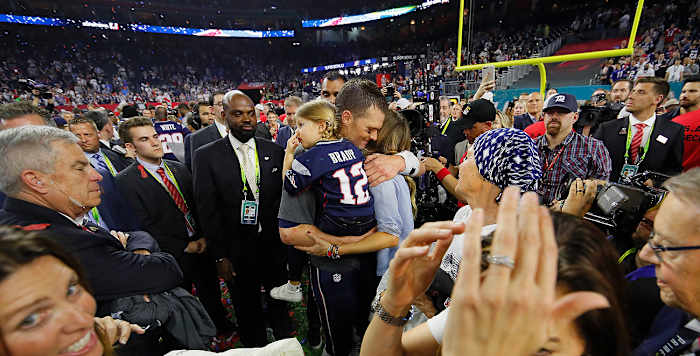
Family played an important role for Tom Brady in the aftermath of Super Bowl 51.
Kevin C. Cox/Getty Images
• Brady’s mentality. We saw real, raw, rare emotion from Tom Brady last week as he talked about his father and his ailing mother. Add that to all the emotional wear-and-tear from two years of Deflategate, and you might think that the Patriots quarterback had a lot to organize mentally going into Super Bowl Sunday. It probably shouldn’t surprise anyone, then, that he’d taken care of that.
Few people have become as ingrained in Brady’s inner-circle over the past decade as Alex Guerrero, whom Brady refers to as his body coach. The reality of what Guerrero does for Brady is pretty much all-encompassing; he’s probably more of a life coach. And so it makes sense that it’s Guerrero who was there to help the Patriots quarterback properly understand his emotions going into the biggest game—or one of the seven biggest games, actually—of his life. “We talk about it,” Guerrero said. “And we work on it an awful lot. He does a great job of being able to compartmentalize emotions and put them where they need to be. And then he expresses them when he needs to express them.”
The expressing happened before the game, when the teams took the field for warmups; the compartmentalizing came before kickoff. And it’s not like Brady just snapped his fingers and made it happen. According to Guerrero, he did put effort into making sure everything was where it needed to be for kickoff. “There’s a lot of meditation that goes into it, a lot of conversation, a lot of mindfulness,” he said. “It all goes into helping him get to the right place.” And the reward for that work was there for Brady to collect when the Patriots were down 28-3. What’s interesting about it, to me at least, was how blocking all of that out was so key to attaining redemption personally and generating such an incredible memory for everyone in his family during such a tough time.
In the end, Guerrero conceded, this win was “a little different” and for more than one reason. “Everything,” he said. “That’s a good way to put it—everything. It’s been a long 18 months. … I’m just so happy for him. I see that every day. The person everybody gets to see out here, that’s who I see every day.” Now, there are a few quarterbacks out there (Drew Brees is another) who surround themselves with the sort of performance team Brady has. This is just one example of the benefit.
• Sark-infested waters. A few years ago I was told to keep my eye on Steve Sarkisian as a potential NFL head coach. A number of teams, including the Rams in 2012, had kicked the tires on the former Washington and USC coach, and his pro-style background was reason to believe that he could make the transition smoothly. All the chatter came to a halt when USC fired him in the wake of a string of alcohol-fueled incidents, but that doesn’t mean the guy never had the potential people saw in him before then. And that’s why the Falcons’ outside-the-box hire of Sarkisian on Tuesday made plenty of sense to me. His system translates to Kyle Shanahan’s, which was a priority of Dan Quinn’s; Sarkisian is familiar with the program Quinn has set up, since both have Pete Carroll ties.
The interesting thing here is how close Sarkisian actually came to becoming an NFL head coach in 2007. Al Davis fired Art Shell that January and quickly targeted the then-USC offensive coordinator, whom he’d worked with in 2004. (Sarkisian was Oakland’s QB coach that year.) The Raiders owner dispatched his right-hand man, John Herrera, to Los Angeles to meet with Sarkisian. Ultimately Sarkisian pulled his name from consideration, but he had told Herrera that he’d want to bring his co-coordinator at SC, Lane Kiffin, with him if he were to take the job. Kiffin, of course, wound up getting the job. “Al was always very intrigued with offensive minds,” Davis’s then CEO, Amy Trask, told me Thursday. “And I do recall a conversation with Al where he spoke highly of his interactions with Steve. I didn’t interact with Steve during the process, but knew him from [2004]. He was definitely intrigued, based on their discussions on offense.”
Say what you will about Davis, but he had a knack for identifying smart offensive coaches early (see Jon Gruden). To me, that’s a nice sign from the past that Sarkisian is capable of clearing the very high bar Shanahan has set.
• San Francisco’s coaching staff screams synergy. It’s been no secret in league circles over the past few years that Kyle Shanahan had his band of coaches rounded up for whenever his shot came. And it’s been obvious, too, that many of those guys mirrored the traits Shanahan brings to the table. So it is with the guys you’re hearing attached to him now as targets to join the new Niners staff.
Robert Saleh worked with Shanahan in Houston. Mike McDaniel was with him in Houston, Washington, Cleveland and Atlanta; Richard Hightower worked with him in Houston and Washington; Jon Embree worked with him in Washington; Mike LaFleur was with him in Cleveland and Washington; and Rich Scangarello was on his staff in Cleveland. And then there’s Bobby Turner, who coached for 14 years under Mike Shanahan in Denver, then another four in Washington, where he worked alongside Kyle. All of these guys are cerebral and driven, which gives you some insight into the culture Shanahan will be looking to build. And they’re all also a little edgy and opinionated, which seems to tell you there will be an open forum of ideas within the staff.
The other key element that shouldn’t be overlooked? These guys have earned Shanahan’s trust, which is important in the sort of environment where it seems like pushback will be encouraged. And again, a lot of these coaches are like the new head coach himself, which plays to CEO Jed York’s desire for better organizational alignment. A few weeks ago, I wrote about Brian Hoyer’s feeling that the younger Shanahan and Belichick are alike. (Hoyer played for both.) This is another area where you see it, I think, with the head coach bringing in guys who have all the tools and the capacity to develop. That’s one reason why I think he isn’t naming an offensive coordinator. Like Belichick did with Eric Mangini, Josh McDaniels, Bill O’Brien and Matt Patricia, he’ll be looking for someone (maybe McDaniel, who’ll coordinate the run game) to earn it.
The overall idea here is to bring coaches through the system who are rooted in similar beliefs. That’s worked to a remarkable level in New England. We’ll see how it flies in San Francisco.
• Don’t do it, NFL! In September, Panthers coach Ron Rivera openly expressed his displeasure with the league scheduling his defending NFC champions for the Thursday night season opener in Denver. “Being defending NFC champs, it’d have been nice to open the regular season at home. But it didn’t work out that way,” Rivera said. “I don’t set the schedule. We just go out and play the game. So we’re going to play the game to the best of our ability and hopefully do things the right.” That displeasure certainly was felt throughout the Panthers organization in the spring and summer of 2016, but the reasoning I heard for it was a little different than the home/away dynamic Rivera cited.
It’s actually pretty simple. Every team but one wants to put the way the season ended behind it, especially the one team that came closest to winning it all. That was what Rivera wanted—find a way to make good on all the reasons why Carolina was 17-1 heading into Super Bowl 50, and not feel the aftereffects of the crash landing once it got there. That, of course, is much harder to do when the schedule shows the team you last lost to in Week 1. So while Rivera and his coaches were trying to move the players past the sting of their Von Miller-induced nightmare, they had no choice but to continue to show them tape of it in preparation for the opener. Did it change anything in how 2016 played out for Carolina? Maybe, maybe not. But I know the Panthers weren’t happy about it.
So it’ll be interesting to see if it happens again. The Falcons are the most interesting opponent on the Patriots’ home slate. It’ll be tempting to slot that one for Sept. 7. If they want to be fair about this, NFL schedule-makers should resist the urge.
* * *
OFFSEASON LESSON TO LEAVE WITH YOU
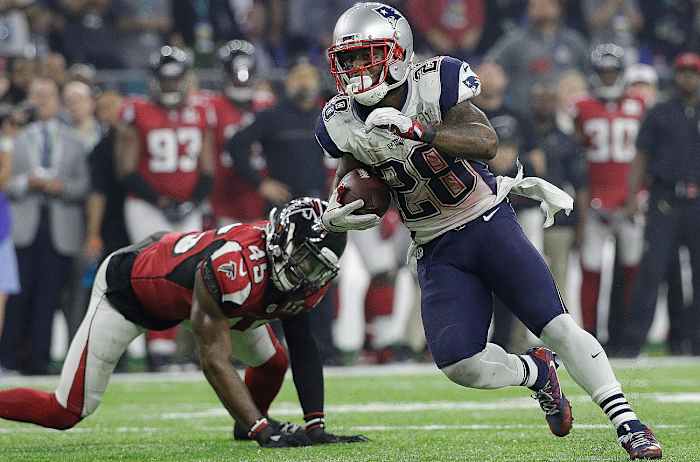
James White was targeted 16 times against the Falcons and finished with 14 receptions, both career highs.
Jae C. Hong/AP
Think you’ve got a handle on the 2016 draft class now? Think the teams have answers on all their players?
Here are four names: Malcolm Butler, Marcus Cannon, Logan Ryan, James White.
Those four played a total of 42 snaps—15 on special teams—for the Patriots in Super Bowl 49. Butler was the team’s fourth corner, Ryan the fifth corner, Cannon was the fourth offensive tackle and White was inactive for that game. The following summer Butler was the only one of the four who was considered a lock to make the roster going into training camp.
Two years later? Those four played a total of 271 snaps in Super Bowl 51, only three of them coming on special teams. Butler and Ryan, the team’s top two corners, played every defensive snap. On offense, so did Cannon, now considered a rock-solid starting right tackle. White played 71 snaps and had 14 catches for 110 yards, six rushes for 29 yards, and scored three of the Patriots’ four touchdowns.
So there’s our lesson for the week: Patience matters in player development.
And I think that’s an area where the Patriots are better now than they’ve ever been. Ryan was a third-rounder, White was a fourth-rounder, Cannon was a fifth-rounder and Butler was undrafted. Each of those guys came through the ranks. Each developed at a different rate. Each became a difference-maker.
When I laid out all this to a respected personnel chief for an AFC rival, he responded like this: “That’s long-term vision and a plan for the players. What roles can they fill? And it’s coaching and player development, and good self-evaluation—what you have today, and what you think you have tomorrow, and then the timing in making decision based on your assessments.”
Ultimately the Patriots didn’t pay Darrelle Revis or Brandon Browner or Shane Vereen, and their replacements were right there in-house. In the case of Cannon, the team was protected when former All-Pro Sebastian Vollmer started breaking down physically.
Now, imagine if one of these players was in Cleveland or San Francisco the past three years, with three different head coaches, different position coaches, different people in personnel, etc. I’d say there’s a good chance at least a couple of them would be out of the league by now, because the people who picked them and would be overseeing their development would be gone.
I know I’ll remember all this when the Patriots lose a couple big names this offseason. I’d certainly say the past couple of years, they’ve earned the benefit of the doubt there.
• Question or comment? Email us at talkback@themmqb.com.

































